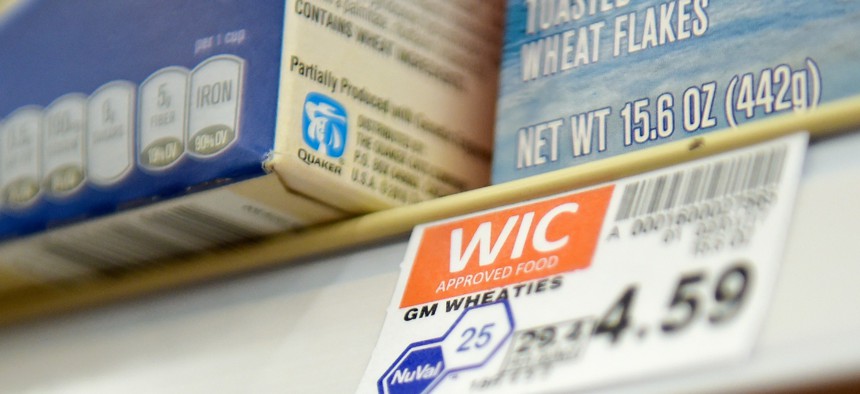USDA looks to modify a key nutrition program for the online age

Items approved for the WIC program are labeled on a store shelf. ewis Geyer/Digital First Media/Boulder Daily Camera via Getty Images
USDA wants to modernize WIC to allow for online shopping, but tech and regulatory hurdles need to be cleared.
The Department of Agriculture is looking to add online shopping to the nation’s third largest federal nutrition assistance program – the Special Supplemental Nutrition Program for Women, Infants, and Children (WIC) – meant to help low-income moms and kids.
Proposed regulations to allow online transactions could be coming as soon as April, but moving WIC online long-term will require rewriting regulations meant for a program delivered with paper vouchers in brick-and-mortar stores.
WIC advocates frame these efforts in terms of equity and accessibility for a program that’s long struggled with participation rates.
Currently, WIC is only reaching six of every ten people who are eligible, Sarah Widor, deputy associate administrator for supplemental nutrition safety program at USDA, told FCW.
The Biden-Harris administration directed the Agriculture Department to test online purchasing in a 2021 executive order meant to increase trust in government by making government services more accessible. Efforts to enable online shopping with WIC also have backing from Congress, which sent USDA $390 million for outreach, innovation and program modernization in the American Rescue Plan Act.
That money and flexibilities around program rules and requirements represent a “unique opportunity,” said Widor. The program has been able to invest in modernization and innovation “around the margins,” she explained, “but we only had a very, very small pool of resources.”
Now, USDA is focusing on improving program delivery and shoring up participation.
Current rules require WIC transactions to be authenticated either by a signature on a check or entering a pin for an electronic benefits transfer card in front of a cashier, said Brian Dittmeier, senior director of Public Policy at the nonprofit National WIC Association. Virtual vendors also aren't accounted for in the rulebook.
Since the onset of the pandemic, some states have started pursuing online options with in-store or curbside pickup, which can be made compliant by including a cashier.
Other states are pursuing pilots that waive cashier requirement as allowed for COVID-19 relief legislation. In 2020, USDA gave a $2.5 million grant for a 3-year project to the Gretchen Swanson Center for Nutrition, which is working with state subgrantees to pilot online ordering. Minnesota, South Dakota, and Washington were tapped as project leads last year.
USDA hopes it’ll be able to fund more projects with the boost from Congress in coming years, Widor said.
Most states in the pilot are still in the contracting phases, with Washington set to go live in the fall, said Paul Throne, state WIC director for Washington, at a February conference held by the nonprofit National WIC Association.
Throne’s hope is that online ordering stays available without any break in service once the pilot ends, but that’s pending the availability of waivers for the rules that bar online transactions. Current waivers last through fiscal year 2024, said Widor.
More widespread availability for online shopping with WIC will bring it in line with the Supplemental Nutrition Assistance Program or SNAP, which Congress first authorized to start working on online ordering in 2014 and was able to scale up pilots after the onset of the pandemic.
“WIC families really deserve to have the same fair shopping choices and experiences as any other family,” said Anotina Kiefer, WIC Advisory Council member and former WIC client at the conference. WIC was a “lifesaver” for her family, she said. “We had to live from paycheck to paycheck and we were on a very tight budget.”
One thing USDA will have to consider in rewriting regulations is how vendors are authorized.
A 2021, congressionally-mandated WIC task force recommended that USDA changes rules so it can authorize vendors nationally – something that currently happens at the state level. This could help allow national, online retailers like Amazon to get onboard.
It’s also yet to be seen how USDA will approach the fees associated with home delivery. For SNAP online ordering, participants have to cover them; but that can put the option out of reach for some people, said Dittmeier, whose organization wants fees to be covered for participants.
The WIC transaction is also complicated, said Widor. It specifies food items, quantities and products, making substitutions for out of stock items – a feature of online grocery shopping platforms – difficult.
There are also questions about broadband access; access to shipping in remote areas and ensuring smaller vendors have tools and money for online ordering.
Ultimately, these efforts go beyond the tech needed for things like online shopping or certifying someone for a government program over a video call.
"There are certainly going to be technology tools or resources that can help make improvements," said Widor of additional efforts happening alongside work on online shopping to make WIC easier to enroll in. Waivers during the pandemic allowed states to use online enrollment, as opposed to requiring people to come into an office to get started with the program.
“What we don’t want to happen is that we have online platforms set up that are just as frustrating as the in-store shopping experience,” Widor said.



